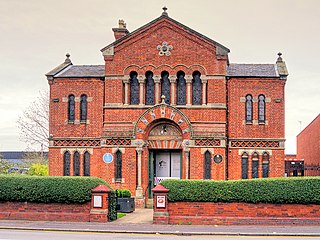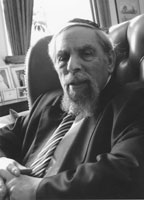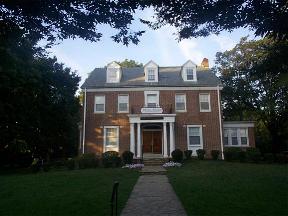
The Manchester Jewish Museum is a Jewish history museum, located on 190 Cheetham Hill Road in Manchester, England, in the United Kingdom. The museum occupies the site of a former Orthodox Jewish synagogue, the place of worship for the Congregation of Spanish & Portuguese Jews, called the Spanish & Portuguese Synagogue, also the Sha'are Tephillah Synagogue. The congregation worships in the Sephardic rite from premises located at 18 Moor Lane, Kersal, Salford.

Louis Jacobs was a leading writer, Jewish theologian, and rabbi of the New London Synagogue in the United Kingdom. He was also the focus in the early 1960s of what became known as the "Jacobs Affair" in the British Jewish community.

Neologs are one of the two large communal organizations among Hungarian Jewry. Socially, the liberal and modernist Neologs had been more inclined toward integration into Hungarian society since the Era of Emancipation in the 19th century. This was their main feature, and they were largely the representative body of urban, assimilated middle- and upper-class Jews. Religiously, the Neolog rabbinate was influenced primarily by Zecharias Frankel's Positive-Historical School, from which Conservative Judaism evolved as well, although the formal rabbinical leadership had little sway over the largely assimilationist communal establishment and congregants. Their rift with the traditionalist and conservative Orthodox Jews was institutionalized following the 1868–1869 Hungarian Jewish Congress, and they became a de facto separate denomination. The Neologs remained organizationally independent in those territories ceded under the terms of the 1920 Treaty of Trianon, and are still the largest group among Hungary's Jews.
Jews in Philadelphia can trace their history back to Colonial America. Jews have lived in Philadelphia since the arrival of William Penn in 1682.
The history of Jews in Charleston, South Carolina, was related to the 1669 charter of the Carolina Colony, drawn up by the 1st Earl of Shaftesbury and his secretary John Locke, which granted liberty of conscience to all settlers, and expressly noted "Jews, heathens, and dissenters". Sephardi Jews from London were among the early settlers in the city and colony, and comprised most of its Jewish community into the early 1800s.

The history of the Jews in the Netherlands largely dates to the late 16th century and 17th century, when Sephardic Jews from Portugal and Spain began to settle in Amsterdam and a few other Dutch cities, because the Netherlands was an unusual center of religious tolerance. Since Portuguese Jews had not lived under rabbinic authority for decades, the first generation of those embracing their ancestral religion had to be formally instructed in Jewish belief and practice. This contrasts with Ashkenazi Jews from central Europe, who, although persecuted, lived in organized communities. Seventeenth-century Amsterdam was referred to as the "Dutch Jerusalem" for its importance as a center of Jewish life. In the mid 17th century, Ashkenazi Jews from central and eastern Europe migrated. Both groups migrated for reasons of religious liberty, to escape persecution, now able to live openly as Jews in separate organized, autonomous Jewish communities under rabbinic authority. They were also drawn by the economic opportunities in the Netherlands, a major hub in world trade.
The history of Jews in Australia traces the history of Australian Jews from the British settlement of Australia commencing in 1788. Though Europeans had visited Australia before 1788, there is no evidence of any Jewish sailors among the crew. The first Jews known to have come to Australia came as convicts transported to Botany Bay in 1788 aboard the First Fleet that established the first European settlement on the continent, on the site of present-day Sydney.

The history of the Jews in Cincinnati occupies a prominent place in the development of Jewish secular and religious life in the United States. Cincinnati is not only the oldest Jewish community west of the Allegheny Mountains but has also been an institutional center of American Reform Judaism for more than a century. The Israelite, the oldest American Jewish newspaper still (2019) being published, began publication in Cincinnati in 1854.
The Belfast Jewish Community is the Jewish community in Belfast, Northern Ireland. Its Rabbi is the Rev David Kale. The community follows the Ashkenazi Orthodox ritual. Membership has fluctuated from 78 in 1900, approximately 1500 during World War II, about 375 after World War II, to 350 in 1945, 380 in 1949 and 200 in 1999. The congregation was fewer than 80 people as of January 2015.
Shangarai Chasset, also called Shaarei Chesed, was an Orthodox and later, Reform, Jewish congregation and synagogue, located in New Orleans, Louisiana, in the United States. The congregation worshipped in the Sefardi rite.
The history of the Jews in Omaha, Nebraska, goes back to the mid-1850s.
Congregation Beth Israel was a Reform Jewish congregation and synagogue, located for most of its history at 761 Chestnut Street in Gadsden, Alabama, in the United States. An outgrowth of Gadsden's Jewish religious school, it was founded in 1908 and incorporated in 1910. It moved into its Chestnut Street building in 1922, and joined the Union of American Hebrew Congregations in 1924.

From about 1590 on, there had been a Portuguese Jewish community in Hamburg, whose qehilla existed until its compulsory merger with the Ashkenazi congregation in July 1939. The first Sephardic settlers were Portuguese Marranos, who had fled their country under Philip II and Philip III, at first concealing their religion in their new place of residence. Many of them had emigrated from Spain in the belief that they had found refuge in Portugal.

The Exeter Synagogue is a Jewish synagogue, located in Synagogue Place, Mary Arches Street, in the old city of Exeter, Devon, England, in the United Kingdom. Established in the 1720s as the Exeter Hebrew Congregation, an Orthodox congregation that worshiped in the Ashkenazi rite, the congregation has been led by laity since c. 1990s, and caters to all shades of Judaism including Reform, Liberal, Masorti and other Jewish denominations.
Jews have been living in Maine, a state in the northeastern United States, for 200 years, with significant Jewish communities in Bangor as early as the 1840s and in Portland since the 1880s. The arrival of Susman Abrams in 1785 was followed by a history of immigration and settlement that parallels the history of Jewish immigration to the United States.

Cheetham Hill Road is a road in north Manchester, England, running from Corporation Street in Manchester city centre, through Cheetham to Prestwich. In Crumpsall, its name changes to Bury Old Road.

The Manchester Reform Synagogue is a Reform Jewish congregation based in Central Manchester, England, in the United Kingdom. The congregation, founded in 1857 as the Manchester Congregation of British Jews, is one of the oldest Reform communities in the United Kingdom, and is a member of the Movement for Reform Judaism.

Few Jews arrived in Baltimore, Maryland, in its early years. As an immigrant port of entry and border town between North and South and as a manufacturing center in its own right, Baltimore has been well-positioned to reflect developments in American Jewish life. Yet, the Jewish community of Baltimore has maintained its own distinctive character as well.

The history of the Jews in San Francisco began with the California Gold Rush in the second half of the 19th-century.

Kingston upon Hull, on England's East Coast was, by 1750, a major point of entry into Britain for traders and migrants, second only to London for links to the continent. Around then, a few Jews from German and Dutch cities lodged and settled in Hull. Selling jewelry and dealing goods in the thriving port and market town, they maintained contacts with Europe, London, and many other – particularly Northern – towns. The small community produced its own institutions and leaders, which were tested by anti-Jewish sentiment, and later by an influx of East-European refugees.















